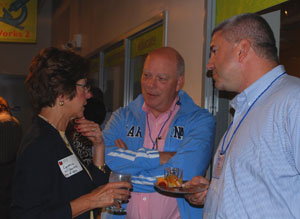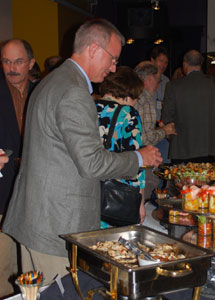Chapel Hill, Welcome to Ann Arbor
Over 100 community leaders from the Chapel Hill, N.C. area traveled to Ann Arbor this weekend to learn about this city – its town/gown relations, approach to economic development, social services, environmental stewardship and other shared issues, like which city’s residents complain more about parking.
They’ll be here through mid-Tuesday, holding sessions with a variety of local people in government, business and nonprofit groups. The group kicked off the visit with a reception Sunday evening at the Ann Arbor Hands-On Museum. [.pdf of complete agenda]
This kind of visit isn’t unusual – representatives from Bloomington, Ind., traveled here several years ago, and folks from Ann Arbor have done the same, over the years taking contingents to Austin, Texas and, yes, Chapel Hill. (I went on that Chapel Hill junket about 10 years ago as a reporter with The Ann Arbor News.)

Developers Peter Allen of Ann Arbor, left, and D.R. Bryan Jr. of Chapel Hill, at Sunday's reception at the Ann Arbor Hands-On Museum.
The Chapel Hill group chose Ann Arbor after looking at about a dozen possible locations. “There was something ineffable about Ann Arbor that convinced us. We’re doing a lot of things better than they are, but we really had a sense of a different kind of community, a place we can learn from,” Linda Convissor, one of the trip’s organizers, told The Herald Sun, a newspaper covering Chapel Hill, Durham and the Research Park region.
Trips like these aren’t unconditionally supported, though. This summer, three aldermen from Carrboro, a smaller town neighboring Chapel Hill (think Ypsilanti), questioned the value of the trip. Alderman Randee Haven-O’Donnell had this to say to the local newspaper: “This is the wrong time to be spending on non-specific, untargeted items. I do not think the Ann Arbor trip is a sound investment.”
The trip costs between $1,130 to $1,295 per person, depending on whether you doubled up at Campus Inn, where the group is staying. The tab includes meals and transportation, too, and is usually paid for by the institution that employs the person making the trip. The University of North Carolina has the largest number of people attending.

Walter Sturdivant, president and general manager of the Chapel Hill radio station WCHL-1360, was broadcasting live from Sunday's reception.
At Sunday’s reception, Jim Heavner – owner of WCHL-1360, a Chapel Hill radio station and one of the trip’s sponsors – urged people to respond to skeptics by saying it’s just like getting a college education: You can’t possibly know its value until after you have it. He spoke of using Ann Arbor as a foil, “to stimulate us to think about doing things a little differently.” The station was broadcasting live from the reception, and will broadcast hourly updates about the visit on Monday.
Most of the sessions will be held at Campus Inn. They’ll also take bus tours of Ann Arbor – to Food Gatherers, the Environmental House, and Spark’s business incubator on East Liberty, among other destinations – and have dinner on Monday night at Zingerman’s Roadhouse. And there’ll likely be at least some people who escape the formal sessions, choosing to explore the city on their own instead.
Bottom line, it’s the shared experiences that might matter most. Quoted in Sunday’s Herald Sun, Mariana Fiorentino, who led the planning committee for this trip, said: “What we’re looking here for is the synergy that will come out of the trip. We’re looking for ways those who are coming will be able to make a difference when they come back home.”
UPDATE (and hyperbole alert): An article published in Monday’s Herald Sun bases its report on a 90-minute bus tour taken by the group Sunday and led by local developer Peter Allen. “We want to show you the advantages of density and how we are re-tooling our entire community for mass transit…We are densifying our downtown and trying to eliminate cars from the community because we believe that there are environmental advantages, public health advantages and safety advantages to doing so.” The article makes the bizarre statement that “Ann Arbor is planning on replacing its buildings that are four to seven stories tall with ones that will be ten to twenty stories high.” [Here's a link - but warning: This site requires you to register before gaining access to its articles.]







I’m interested in what other “bizarre statements” you have heard coming from this visit. I’ve questioned the good sense of making this out-of-state junket – heavily weighted with developers who have business before some of the elected officials – in general. Doing so in the name of environmental and economic sustainability seems quite absurd.
This isn’t the first time Chapel Hill has visited Ann Arbor. It was their original trip here that inspired the (much smaller) trip to Chapel Hill that Mary was a part of. It would be interesting to see whether they believe we’ve made progress since their last visit.
Sue, I’ll try to follow up on that. I either didn’t know (or more likely, forgot) that Chapel Hill folks have been here before. Wonder how many people from the first trip are on this one.
CitizenWill, it’s hard to know if the reporter misunderstood, or if his source (who wasn’t identified) made some kind of misstatement. I characterized it as “bizarre” because, well, no one (that I know of) wants to tear down shorter buildings en masse just to build taller ones. And some of the taller buildings that are proposed are facing opposition. It’s a contentious issue here – lots of people say they support greater density. But when faced with a specific project, there’s not as much happy talk.
We are going through the same issue with “bigger is better”. Chapel Hill used to have a human-scale Downtown but our current elected folks are doing their best to ram-rod “tall” Downtown. Beyond the aesthetic issues, there are issues of costs – both direct and indirect – foisted upon the community. We’re already involved in a public-private partnership that will cost a reported $8.5M, has already cost North of $1.5M and has secondary costs of at least $1M which I fully expect to increase dramatically. In the case of that project, the public is on the hook while the developer reaps the rewards of selling million-dollar penthouses. Beyond that, the indirect costs to the surrounding community – a large part of which is what remains of a traditionally diverse population – is not factored. Why? Because the not so secret secret is our public policy is driven by catering to upper-tier developers that want to cash in on Chapel Hill’s cachet – a cachet they’re quickly destroying.
There was another misstatement on that tour that an effort was afoot to “eliminate cars from the community because we believe that there are environmental advantages, public health advantages and safety advantages to doing so.” Since no city in the world has eliminated cars (including transit wealthy communities like NYC, Paris and Portland) it’s hard to imagine that Ann Arbor would strive for such a goal. What is true is the huge strides we have made to provide transportation options in our community, including Nightride Shuttles, go!passes, the LINK, A2/Chelsea Express, Rideshare, bike locker rentals and soon Zipcar and commuter rail service. We’ve made most progress by framing the question as how to increase options, not reduce them.
Mary,
This Ann Arbor native and Chapel Hill resident thought this was a pretty bizarre statement as well:
Many of the homes on campus are more than 100 years old, and have traditionally been rented to students. The town and UM have argued over what is historic and should be preserved, and what is just old, said Jesse Bernstein, president of the Ann Arbor Chamber of Commerce.
Sometimes the university wins, and the houses are preserved. Sometimes the city wins, and it gets the go-ahead to erct a 10-story mixed use facility.
Link:
http://dthannarbor.wordpress.com/2008/09/15/a-tour-of-ann-arbor/
I must have missed all those battles where the university stood up to the city in support of historic preservation against redevelopment. Again, not sure whether it’s bad reporting or the Ann Arbor folks were spreading misinformation.
Love the new venture.
In regards to the comments of Tom Jensen, it is not poor reporting that is the problem but the misinformation being spread by the President of the CVB that is the issue. He continually gets things wrong, or has his own spin on what is historic. No one ever contacted the Historic District Commission for this visit, despite the fact that the Campus Inn abuts the Old Fourth Ward historic District and has many beautiful homes and churches nearby. And some of these homes are actually occupied by ‘real’ people (like myself).
What Mr. Bernstein doesn’t seem to realize is that our historic districts are a part of our city’s governance. It is not a matter of old vs. historic. The properties in these districts are reviewed by the HDC when changes are proposed. However, the University is not subject to ANY city regulations, including historic districts, so if it buys a building with a historic designation it cannot be stopped from tearing it down. This was the case with the Planada Apt bldg on Ann St. It is unfortunate that this disiniformation is being spread by such a reputable source and no one has the able to counter it.
Just to clarify: Jesse Bernstein is president of the Ann Arbor Area Chamber of Commerce. Mary Kerr (who also was involved in the Chapel Hill visit) is president of the Ann Arbor Convention & Visitors Bureau (CVB).